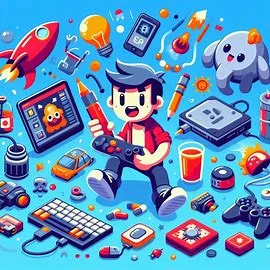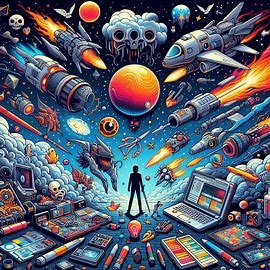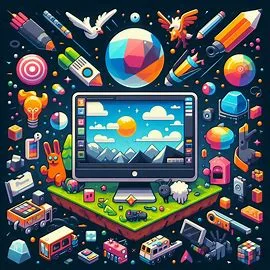HTML5 Game Engines
It’s no secret that HTML5 game engines have revolutionized the world of game development, making it more accessible to aspiring developers than ever before. With the power of HTML5, CSS, and JavaScript, creating interactive games for the web has become a reality for everyone. In this comprehensive guide, we will walk you through everything you need to know to look into the world of HTML5 game development and unleash your creativity.

Definition and Role of a Game Engine
For game developers, an engine is the backbone of any game development project. It is the software framework that provides developers with the necessary tools and features to create and deploy games efficiently. A game engine typically includes rendering capabilities, physics simulation, sound, scripting, animation, AI, networking, and more.
Game engines act as a centralized hub where developers can build, design, and optimize their games. They streamline the development process by offering pre-built functionalities, allowing developers to focus on game design and mechanics rather than reinventing the wheel with each project.
Comparison with Traditional Game Development
For those familiar with traditional game development methods, the use of a game engine can be a game-changer. Here is a comparison between using a game engine and traditional game development:
| Game Engine | Traditional Game Development |
| Pre-built tools and features | Custom-built from scratch |
| Streamlined development process | Time-consuming and labor-intensive |
| Allows for cross-platform deployment | Platform-specific development |
Using a game engine not only saves time and resources but also opens up possibilities for developers to create high-quality games with reduced development cycles. The convenience of having a wide range of features readily available in one package is a significant advantage that game engines offer.
Game
| Efficiency | Resource-saving |
| Rapid development cycles | Reduced development time |
| Accessible to developers of all levels | Low barrier to entry |
Features of HTML5 Game Engines
You can create amazing games using HTML5 game engines which offer a range of features to make game development easier and more efficient. In this chapter, we will explore some of the key features that HTML5 game engines provide to developers.
Cross-Platform Compatibility
Engines designed for HTML5 games are known for their cross-platform compatibility, allowing games to run seamlessly on various devices and operating systems. This feature is crucial for reaching a wider audience and ensuring that players can access the game on their preferred devices.
With HTML5 game engines, developers can write code once and deploy it across multiple platforms without the need for extensive modifications. This flexibility simplifies the development process and reduces the time and effort required to create games for different devices.
Graphics and Animation Capabilities
Graphics are a vital component of any game, and HTML5 game engines offer a wide range of graphics and animation capabilities to make your game visually appealing. These engines provide tools and libraries for creating stunning visuals, smooth animations, and special effects to enhance the overall gaming experience.
Animation plays a crucial role in bringing games to life, and HTML5 game engines come with built-in support for creating dynamic animations that react to user input or game events. By utilizing these animation features, developers can create immersive gameplay experiences that captivate players.
Animation integration in HTML5 game engines allows developers to easily incorporate complex animation sequences, character movements, and environmental effects into their games. By leveraging these animation capabilities, developers can add depth and realism to their game worlds.
Audio and Music Integration

Compatibility with various audio formats and seamless integration of music and sound effects are key features of HTML5 game engines. These engines provide developers with tools to incorporate audio elements that enhance the overall gaming experience and create an immersive atmosphere for players.
Integration of audio and music in HTML5 game engines allows developers to synchronize sound effects with in-game actions, create dynamic soundtracks based on gameplay events, and add depth to the game world. By leveraging these audio features, developers can engage players on an auditory level and enhance the overall gaming experience.
Physics and Simulation
To create realistic interactions and behaviors within games, HTML5 game engines offer physics and simulation capabilities that simulate real-world phenomena such as gravity, collisions, and object dynamics. These features allow developers to create challenging puzzles, lifelike movements, and dynamic environments in their games.
Physics engines in HTML5 game development provide developers with tools to apply realistic physics to game elements, enabling objects to move, collide, and interact with each other in a believable manner. By incorporating these simulation features, developers can create engaging gameplay experiences that challenge and entertain players.
Physics simulation in HTML5 game engines enables developers to create experiences where objects interact realistically with the game environment and respond accurately to player input. By utilizing these simulation capabilities, developers can create games that feel immersive and responsive to player actions.
Popular HTML5 Game Engines
HTML5 game development has surged in popularity, and a key component of this ecosystem is the wide array of game engines available. These engines streamline the development process, offering a range of tools and features to bring game ideas to life.
Among the multitude of options, certain HTML5 game engines have risen to prominence due to their versatility, performance, and community support.

Phaser
Phaser is a fast, free, and fun open-source framework for Canvas and WebGL powered browser games. It provides a rich set of features for creating 2D games, including physics, animations, sound management, and more.
Phaser is widely praised for its ease of use, extensive documentation, and active community support. Developers can quickly prototype and build games for both desktop and mobile platforms using Phaser’s robust tools.
Phaser is known for its flexibility and performance, making it an ideal choice for both beginners and experienced game developers. With a strong emphasis on HTML5 game development, Phaser continues to evolve and push the boundaries of what is possible in the world of browser-based gaming.
Construct
On the other hand, Construct is a powerful and user-friendly HTML5 game engine that allows developers to create games visually without any need for coding. It features an intuitive drag-and-drop interface, making game development accessible to a wide range of users, from beginners to seasoned professionals.
Core features of Construct include a behavior system for adding logic to game objects, a powerful event system for defining game logic, and support for exporting games to multiple platforms seamlessly. With a focus on usability and rapid development, Construct is favored by many developers for its efficiency and versatility.
PixiJS
Construct stunning interactive visualizations and engaging games with PixiJS, a 2D rendering engine that works across all modern web browsers. PixiJS utilizes WebGL for rendering, ensuring smooth animations and high performance even on mobile devices.
It offers a simple API for creating graphics, animations, and particle effects, making it a popular choice for creating visually appealing games.
Extensions for PixiJS allow developers to enhance the engine’s capabilities by adding plugins for additional features such as physics, lighting, and audio. With its lightweight nature and focus on rendering speed, PixiJS is a top choice for developers looking to create high-quality games optimized for web and mobile platforms.
Babylon.js
To immerse players in breathtaking 3D experiences, developers turn to Babylon.js, a powerful open-source 3D engine for the web. With support for WebGL and WebXR, Babylon.js enables the creation of stunning 3D games and interactive experiences that run in any browser without the need for plugins.
With advanced features such as physics engines, complex shaders, and Babylon’s own animation system, developers can create immersive worlds that push the boundaries of web-based gaming.
The engine’s active community and extensive documentation provide ample resources for developers to build cutting-edge 3D games that run smoothly across different platforms.
Choosing the Right Game Engine
Many game developers face the daunting task of selecting the right game engine for their projects. With a plethora of options available, it’s crucial to assess various factors to make an informed decision that aligns with your goals and requirements.

Project Requirements Analysis
Requirements analysis is the initial crucial step in choosing a game engine. Factors such as the type of game you’re developing, target platforms, desired graphics capabilities, networking needs, and the level of programming complexity required should all be thoroughly evaluated.
Considering Licensing and Cost
Cost plays a significant role in selecting the right game engine. Some engines offer free versions with limited features, while others require a licensing fee or royalties upon commercial release.
It’s vital to weigh the costs against the features and support provided by each engine to determine the best fit for your budget and project.
It’s important to note that while some game engines may have low upfront costs, the royalties or additional fees that kick in upon commercial release can impact your overall expenses. Be sure to understand all the licensing terms to avoid any surprises down the road.
Community and Documentation
Licensing agreements can also impact your ability to share and collaborate on projects. Some engines have robust communities with active forums and support channels, while others may lack sufficient documentation or community engagement. Assessing the level of community support can be crucial in resolving issues and accelerating the development process.
Documentation
Thorough and easily accessible documentation can make a significant difference in the learning curve and troubleshooting process when working with a game engine.
Engines with comprehensive documentation, tutorials, and examples can help developers navigate challenges more efficiently and make the most of the engine’s capabilities.
Getting Started with Your First HTML5 Game
Now that you’ve decided to look into the exciting world of HTML5 game development, it’s time to start creating your first game. This chapter will guide you through the crucial steps to help you get started on your game development journey.
Setting Up the Development Environment
Game development requires a suitable environment for coding, testing, and debugging your games. The first step is to choose a code editor or integrated development environment (IDE) that suits your workflow. Popular options include Visual Studio Code, Sublime Text, and Atom.
Additionally, you’ll need to install a web browser with robust developer tools, such as Chrome DevTools, to inspect and debug your game as you build it.
Next, you’ll need to set up a local server environment to run your game locally. You can use tools like Node.js with Express or Python with SimpleHTTPServer for this purpose. Setting up a version control system like Git will also streamline your development process and help you track changes in your game’s codebase.
Creating a Basic Game Loop
Any HTML5 game starts with a game loop, a fundamental structure that controls the flow of the game. The game loop handles operations such as updating the game state, rendering graphics, and handling user input.
To create a basic game loop, you need to define functions for updating and rendering the game’s elements, and then continuously call these functions within the loop.
The game loop typically consists of three main phases: updating the game state, rendering the game graphics, and handling user input. By efficiently managing these phases in your game loop, you can ensure smooth gameplay and responsiveness in your HTML5 game.
Creating an efficient game loop is crucial for the performance and playability of your game. By optimizing your game loop to run at a consistent frame rate, you can deliver a more immersive gaming experience to your players. Additionally, implementing techniques such as delta timing and frame skipping can help maintain smooth gameplay across different devices and browsers.
- Optimize your game loop for consistent frame rates
- Implement delta timing and frame skipping for smooth gameplay
After implementing these optimization tips, test your game on various devices and browsers to ensure compatibility and performance across different platforms. By fine-tuning your game loop and addressing potential performance bottlenecks, you can create a compelling HTML5 game that players will enjoy.
Deploying and Testing on Different Platforms
Platforms such as mobile devices, desktop browsers, and gaming consoles offer unique opportunities for deploying and testing your HTML5 games. Each platform comes with its own set of challenges and requirements, so it’s crucial to understand the specifics of each platform before deploying your game.
Different platforms may have varying hardware specifications, screen resolutions, and input methods that can affect the performance and gameplay of your HTML5 game. By testing your game on multiple platforms and optimizing it for each specific device, you can ensure a seamless gaming experience for your players.
- Optimize your game for different screen resolutions
- Test your game on various input methods
After optimizing your game for different platforms and testing it thoroughly, you can deploy your HTML5 game to app stores, online platforms, or your own website. By following best practices for deploying and testing on different platforms, you can reach a broader audience and maximize the impact of your game.
Advanced Topics in HTML5 Game Development
Keep pushing the boundaries of your HTML5 game development skills by exploring these advanced topics:
-
Multiplayer and Networking Learn how to implement real-time multiplayer functionality in your games -
Incorporating Artificial Intelligence Discover how AI can enhance the gameplay experience for your players -
Virtual and Augmented Reality in HTML5 Games Explore how VR and AR technologies can be integrated into your HTML5 games -
Monetization Strategies Implement effective monetization techniques to generate revenue from your games
Multiplayer and Networking
Development in multiplayer and networking opens up a whole new dimension of interactivity in your games. *Utilizing WebSocket technology, you can create real-time multiplayer games where players can compete against each other or collaborate in a shared virtual world.
Implementing networking features allows for seamless communication between players, creating a more engaging and social gaming experience. *
Incorporating Artificial Intelligence
Intelligence Enhance your games with AI-powered opponents, non-player characters, and decision-making systems. *By implementing AI algorithms, you can create more challenging and dynamic gameplay experiences for your players. AI can adapt to player behavior, provide personalized challenges, and create a more immersive gaming environment. *
Any game genre can benefit from incorporating Artificial Intelligence, from strategy games that require complex decision-making to action games that demand quick reactions and adaptability.
*Experiment with different AI techniques such as pathfinding algorithms, decision trees, and neural networks to create unique and engaging gameplay experiences. *
Virtual and Augmented Reality in HTML5 Games
Reality Dive into the world of VR and AR to elevate your HTML5 games to the next level of immersion. *By integrating VR and AR technologies, you can create interactive experiences that blur the line between the virtual and physical worlds.
VR headsets and AR devices can provide players with a more immersive and interactive gaming experience, bringing your games to life in new and exciting ways. *
For instance, you can develop games that utilize AR to overlay virtual elements onto the real world, creating a mixed reality experience for players. *Experiment with VR environments to transport players to fantastical worlds and immerse them in rich, interactive 3D environments. *
Monetization Strategies
Strategies Maximizing revenue from your games requires effective monetization strategies. *Consider implementing in-app purchases, ads, subscriptions, or premium content to generate revenue from your games. Analyze player behavior and engagement metrics to optimize your monetization strategies and maximize profits.*
HTML5 games offer flexibility in monetization options, allowing you to tailor your approach to fit the needs and preferences of your target audience. *Explore different monetization models and experiment with pricing strategies to find the right balance between generating revenue and providing value to your players. *
Conclusion
Presently, HTML5 game engines have revolutionized the way developers create games for web and mobile platforms. With a wide range of tools and features, these engines empower developers to bring their creative visions to life with ease.
Whether you are a seasoned developer or a newcomer to game development, HTML5 game engines provide everything you need to get started and build engaging games.
By leveraging the power of HTML5 game engines, developers can create visually stunning and high-performance games that can be played across various devices.
With a supportive community and available resources, aspiring game developers have the opportunity to learn and grow their skills in this exciting field. With the right tools and knowledge, the possibilities are endless for creating captivating and immersive gaming experiences.

